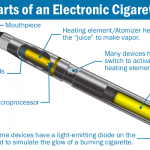Did you know that fresh water in active circulation on our planet – in the atmosphere, as surface waters and groundwaters – is sometimes also referred to as ‘meteoric water’? But don’t be fooled, it has nothing to do with meteors: most meteors contain no ice, just lots of dense minerals. The term ‘meteoric’ originally comes from a Greek expression meaning ‘things high up’, and has come to refer to all atmospheric phenomena. We’ll now take a look at the principal domains through which meteoric water circulates.
Dampening the Atmosphere
At present, atmospheric water vapour accounts for a mere 0.16 per cent of the total fresh water circulating on planet Earth. This is a trivial amount compared to that stored in lakes and rivers, let alone in comparison to groundwater. However, what it lacks in volume it makes up for in speed: where water typically spends a few millennia in the oceans, several centuries in groundwater systems, several years in lakes and several months in rivers, it spends little more than a week in the atmosphere.
This dynamism results in atmospheric moisture playing a crucial role in supporting life and, through erosion, shaping the very surface of our planet. Notwithstanding the impressive steam yields of volcanoes, for several billennia now the vast majority of atmospheric moisture has come from evaporation of sea water.
Water also enters the atmosphere by evaporation from lakes and rivers, of course, and by release from plant leaves (a process called transpiration) – though the amount evaporating from the oceans outnumbers that originating from land by 6 to 1. Even though 80 per cent of all rainfall occurs over the oceans, they still lose more water to evaporation.
The converse is true over land, where precipitation exceeds evapotranspiration overall, mainly due to orographic precipitation: the tendency of hills and mountains to force air masses to rise and cool, thus condensing the moisture they contain to form rain or snow. This is fortunate for us, as, otherwise, non-marine life would never have evolved beyond a few microbes. A further crucial attribute of this ocean-to-land transfer is the distillation process which accompanies evaporation: very little marine salt is entrained in atmospheric moisture, so that rainfall tends to be very weakly mineralized.
The forms which water adopts in the atmosphere are extremely diverse, with gas, liquid and ice phases all common. While we may be accustomed to thinking of clouds as accumulations of gas, many of the most spectacular clouds comprise billions of ice shards. Of course, moisture leaves the atmosphere in all three physical forms, too.
We are all familiar with rain, hail and snow, but what about water vapour? In many parts of the world, night-time cooling leads to the condensation of water vapour on solid surfaces as morning dew. Sublimation is the term used to describe the direct transformation of a gas to a solid.
Thankfully, you don’t have to worry about sublimation or condensation to have your regular supply of drinking water. Companies like Thames Water are ardently working towards achieving their goal of providing clean water and sanitation services to all. If you want to know how to be a customer of this customer-focused company, feel free to call them at Thames Water Contact Number and their friendly teams will answer all your queries related to the issue.































No Comments
Leave a comment Cancel